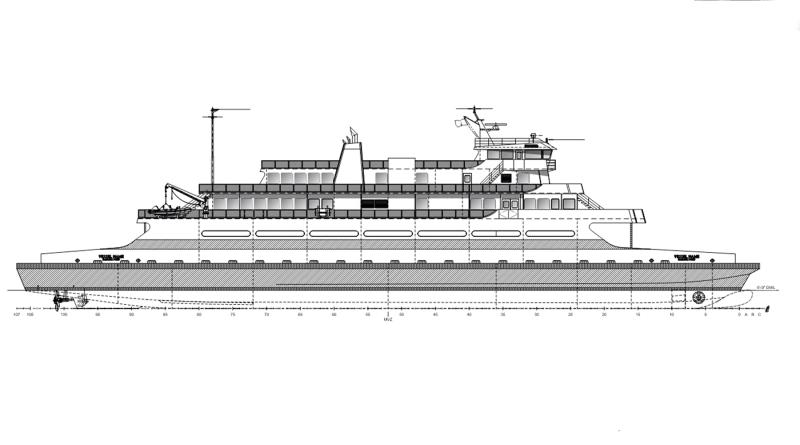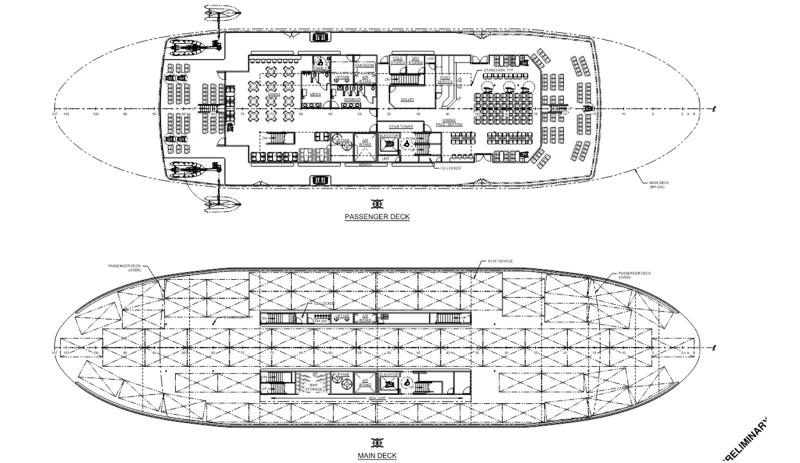The Cape May-Lewes Ferry is planning to phase in smaller boats, with the first vessel docking in Cape May in late 2026.
The move is expected to save the Delaware River and Bay Authority money in operating costs, meet demand over the next 40 years and be more environmentally friendly than the existing fleet.
Plans were unveiled at a Feb. 23 public meeting. DRBA has been working with Elliott Bay Design Group and KPFF Consulting Engineers since 2021 to develop a master plan for the future. Four fleet configuration options were considered, including optimizing the existing fleet of three 100-vehicle, 800-passenger boats. However, analysis determined the best path forward is to move to a mid-size fleet of four 75-vehicle, 330-passenger vessels.
Heath Gehrke, director of ferry operations, said the move will allow DRBA to provide more trips during peak times, while adding flexibility in the shoulder and off-seasons when demand is much lower.
The cost of four new ferries is estimated at $304 million, or $76 million per boat. Additional expenses of $16.1 million bring the grand total to $320 million. Optimizing the existing fleet was estimated at $360 million. After the meeting, DRBA spokesman James Salmon said due to the capital requirements, the plan to replace the entire fleet is a long-term plan – likely more than 10 years.
In addition, the new vessels will be built with a compartment for future alternative energy, saving costs for future retrofitting.
“It might be a battery; it might be some type of fuel cell. We haven’t quite figured that out yet,” Gehrke said. “That will be part of the next part of design. As shoreside infrastructure improves, we would like to add that additional propulsion alternative.”
He said the vessels will be designed to be hybrid. The plan will be to continue to use diesel fuel until an alternative is available. When that happens, he said, trips across the bay may be diesel-free; however, longer trips to the boat yard – typically 20 hours – would likely require some diesel use. Gehrke noted that newly constructed vehicles are required to meet higher standards for emissions, so they’ll be cleaner than the existing fleet.
John Waterhouse of Elliott Bay Design Group said the design of the new ships will have to consider the route between Cape May and Lewes, specifically shallow areas like the Cape May terminal and Crow Shoal in Delaware Bay.
“This is not a cookie-cutter solution,” he said. “The Cape May-Lewes crossing is a unique crossing with unique traffic, and we want to make sure this vessel is bespoke to those needs.”
He said the vessels will have to be light with a shallow-draft hull. They cannot draw too much water, and they must meet the expectations of speed and sea keeping.
Gehrke was asked about the recent population growth in the Cape Region and if that was considered when determining the size of new vessels. He said a minimal amount of annual ridership growth was considered, but it’s difficult to predict future demand for ferry operations.
“For the last 15 to 20 years, we saw a continuing decline, and we reduced the fleet size,” he said. “Then in the last couple of years, we’ve seen growth.”
Waterhouse said ferry ridership doesn’t typically fluctuate too much.
“It’s unclear given the history of the region – where there are amenities on both sides of the crossing – what would drive a substantial increase in ridership,” he said. “Maybe there will be some things down the road that we cannot predict today, but based on historic trends, we don’t see a lot of items that would dramatically increase demand for the ferry service.”
They were asked if a fleet of different-sized boats was considered. Gehrke said that wasn’t considered the best approach, but there will be a transition period where DRBA is operating the exiting ferries with the new boats.
“That may potentially yield some different perspective,” he said. “We also desire to have consistency because that helps when you need spare parts, services.”
Smaller boats will also allow DRBA to operate with a small crew, which Gehrke said would be achieved through attrition.
“There’s no threat to anyone’s job here at the authority – we obviously value them tremendously,” he said.
A smaller crew on a more fuel-efficient boat should result in a cost savings for DRBA, Waterhouse said.
Waterhouse said they’re now wrapping up the fact-finding and analysis phase of the project, and are moving into preliminary design. Final design is expected to be completed by second quarter 2024, with construction of the first vessel expected to begin in the fourth quarter of 2024 and last 24 months.
DRBA is accepting public comments on the plan. To comment, email marinemasterplan@drba.net or leave a voicemail at 609-889-7280, Ext. 27280.
Nick Roth is the news editor. He has been with the Cape Gazette since 2012, previously covering town beats in Milton and Lewes. In addition to serving on the editorial board and handling page layout, Nick is responsible for the weekly Delaware History in Photographs feature and enjoys writing stories about the Cape Region’s history. Prior to the Cape Gazette, Nick worked for the Delmarva Media Group, including the Delaware Wave, Delaware Coast Press and Salisbury Daily Times. He also contributed to The News Journal. Originally from Boyertown, Pa., Nick attended Shippensburg University in central Pennsylvania, graduating in 2007 with a bachelor’s degree in journalism. He’s won several MDDC awards during his career for both writing and photography. In his free time, he enjoys golfing, going to the beach with his family and cheering for Philadelphia sports teams.



























































